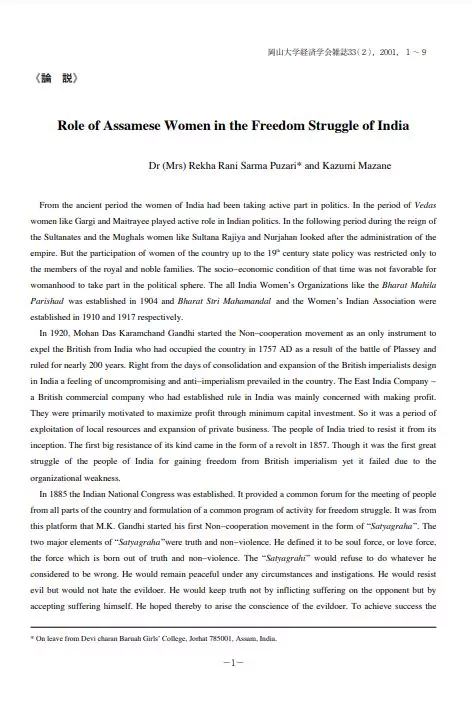‘Role Of Assam In Freedom Movement’ PDF Quick download link is given at the bottom of this article. You can see the PDF demo, size of the PDF, page numbers, and direct download Free PDF of ‘Role Of Assam In Freedom Movement’ using the download button.
Role Of Assam In Freedom Movement PDF Free Download

Role Of Assam In the Freedom Movement
Assam has been under the rule of several dynasties, the most prominent being the Varman dynasty, the Kochs, the Kacharis, and the Ahoms. During the 13th century, Sukapha, a Tai prince from Mong Mao, which is currently a part of China, came to Assam crossing the Patkai range with about 9000 followers, and founded the Ahom dynasty in the year 1228. He ruled the kingdom.
For nearly 600 years, the Delhi Sultanate and the Mughals invaded the state 17 times during this period but failed to establish their authority. However, over time the rule of the Ahoms was weakened due to some internal politics.
Assam was invaded three times by the Burmese between 1817 and 1826, during which time the Assam (Ahom) Kingdom came under Burmese control from 1821 to 1825.
The First Anglo-Burmese War and the Treaty of Yandaboo in 1826 ended the Burmese rebellion in Assam and marked the beginning of British rule. In the year 1826, the British annexed the Ahom Kingdom and in 1838 AD, the entire Northeast India became a part of the Bengal Presidency of British India.
In 1858 the rule of the East India Company ended and the whole of India came under the direct control of the British Crown. The assessment of land revenue was increased by the new administration as income tax, stamp duty, etc.
were also imposed and it traded in opium and salt in the state and made a lot of profit from it. The British realized that the region of Assam was an inherent goldmine for them and got involved in the process of development and progress.
The British disbanded the Ahom administrative structure, made Bengali the official language, and recruited Bengali Hindus to various positions instead of the local population.
Coal, limestone, and iron mines were opened and the government offered incentives to European entrepreneurs to start plantations for the production of tea, rubber, chinchona (a source of quinine), hemp, and jute. The British brought contract laborers from Bihar, Orissa, and Andhra Pradesh.
By the turn of the century, one and a half million such coolies were employed in 700 gardens, producing 145 million pounds of tea annually.
The first rebellion against the British was led by Dhananjay Borgohain and Gunadhar Konwar in 1828 AD. Gunadhar Konwar was sentenced to seven years in prison and after receiving the death sentence, Dhananjay Borgohain fled to the Matak kingdom. There he secretly joined hands with his sons Harkant and Harnath, son-in-law Jeuram Dulia Barua and many others and planned to attack Rangpur.
But before he could he was betrayed by one of his associates, Sadia Khowa Gohain, and several members of the group were hanged and others were expelled from the country. After this, British control over Assam became stronger. The famous Sepoy Mutiny of 1857 echoed in Assam under the leadership of Maniram Dewan and Piyoli Baruah, who were finally hanged in 1858. Meanwhile, the British tried to curb the linguistic independence of the natives by introducing Bengali as the medium of instruction in 1837 AD.
However, it ended in failure as Assamese was restored as the medium of instruction in 1873 AD due to the efforts of American Baptist missionaries and famous intellectuals of the time like Anandram Dhekial Phukan, Hem Chandra Barua, and Gunabhiram Barua.
Like all other Indian states, Assam also played an important role in India’s independence movement. Apart from the Sepoy Mutiny, Assam took an active part in every movement that led to India’s independence. The people of Assam contributed significantly in every phase of the freedom movement from 1920 to 1947.
Mahatma Gandhi’s visit to the state in 1921 gave impetus to the independence movement which had already gathered momentum in both the valleys of Assam.
A 15-year-old girl Kanak Lata Barua became the first martyr of the Quit India Movement in the year 1942 and many others like Kushal Konwar, Kamla Miri, Maniram Dewan, Bhogeshwari Phuknani, etc. also sacrificed their lives for their motherland. Assam’s contribution to India’s freedom movement cannot be ignored.
| Language | English |
| No. of Pages | 9 |
| PDF Size | 0.06 MB |
| Category | General |
| Source/Credits | – |
Related PDFs
Telangana Pathakalu PDF In Telugu
Quit India Movement In Assam PDF
Desha Bhakthi Geethegalu PDF In Kannada
Role Of Assam In Freedom Movement PDF Free Download
